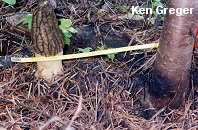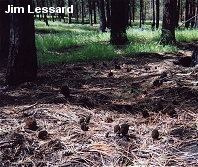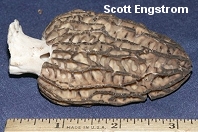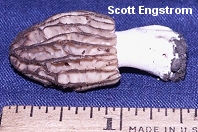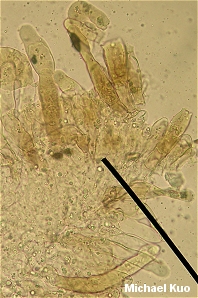| Major Groups > True Morels & Verpas > Morchella sextelata |

|
Morchella sextelata [ Ascomycetes > Pezizales > Morchellaceae > Morchella . . . ] by Michael Kuo On the basis of present data, Morchella sextelata can't be distinguished from Morchella septimelata without DNA testing. Both species appear in burned conifer forests in western North America, primarily in the spring or summer following the fire, but sometimes in dwindling numbers for a few springs thereafter. Both species are "black morels," which means that their ridges darken with maturity, their pits and ridges are primarily vertically oriented, and their caps are attached to the stem with a small but noticeable groove. And no consistent differences in physical features--observed with, or without, a microscope--appear to separate these species. Yet Morchella sextelata separates itself clearly when its DNA is tested--either through the expensive and time consuming, four-gene sequencing routines used by O'Donnell and collaborators (2011), or through basic RFLP analysis of the ITS region alone, as reported by Carter in the Morel Data Collection Project. And while it may be frustrating for folks who want to know exactly what species they have picked, this data can't just be ignored. So we are stuck with a "cryptic pair" of burn-site morels. Describing these species in Kuo and collaborators (2012), I couldn't even come up with distinguishing characters on which to base the names for these two species, and wound up resorting to the fact that they were the sixth (sext-) and seventh (septim-) enumerated members of the elata clade established in O'Donnell and collaborators (2011). Description: Ecology: Possibly saprobic and mycorrhizal at different points in its life cycle; appearing in lightly to moderately burned conifer forests in western and northwestern North America, in the spring or summer following the fire; documented from Idaho, Montana, Washington, Wyoming, and the Yukon Territory. Cap: 2.5-7.5 cm tall and 2-5 cm wide; conical or nearly so; pitted and ridged, with the pits primarily arranged vertically; when young with bald or finely velvety, bluntly flattened, yellowish to brownish ridges and pinkish to yellowish pits; when mature with flattened to sharpened or eroded, dark brown to black ridges and brownish to tan or pinkish pits; attached to the stem with a small groove (2-4 mm deep); hollow. Stem: 2-5 cm high and 1-2.5 cm wide; equal, or somewhat swollen at the base; whitish; bald or finely mealy with granules; hollow. Microscopic Features: Spores 18-25 x 10-16 µ; smooth; elliptical; without oil droplets; contents homogeneous. Asci 8-spored. Paraphyses cylindric with variable apices; septate; hyaline in KOH. Elements on sterile ridges 50-180 x 5-25 µ; septate; brownish to brown in KOH; terminal cell cylindric with a rounded, subfusoid, subcapitate, or block-like apex. REFERENCES: M. Kuo in Kuo et al., 2012. (O'Donnell et al., 2011; Kuo et al., 2012.) SPECIMENS EXAMINED: Herb. F. 06010101, 04250406, 05020402, 06180422, 07070405, 07130403 (holotype), 05270601. This site contains no information about the edibility or toxicity of mushrooms. |
© MushroomExpert.Com |
|
Cite this page as: Kuo, M. (2010, October). Morchella sextelata. Retrieved from the MushroomExpert.Com Web site: http://www.mushroomexpert.com/morchella_sextelata.html. |
